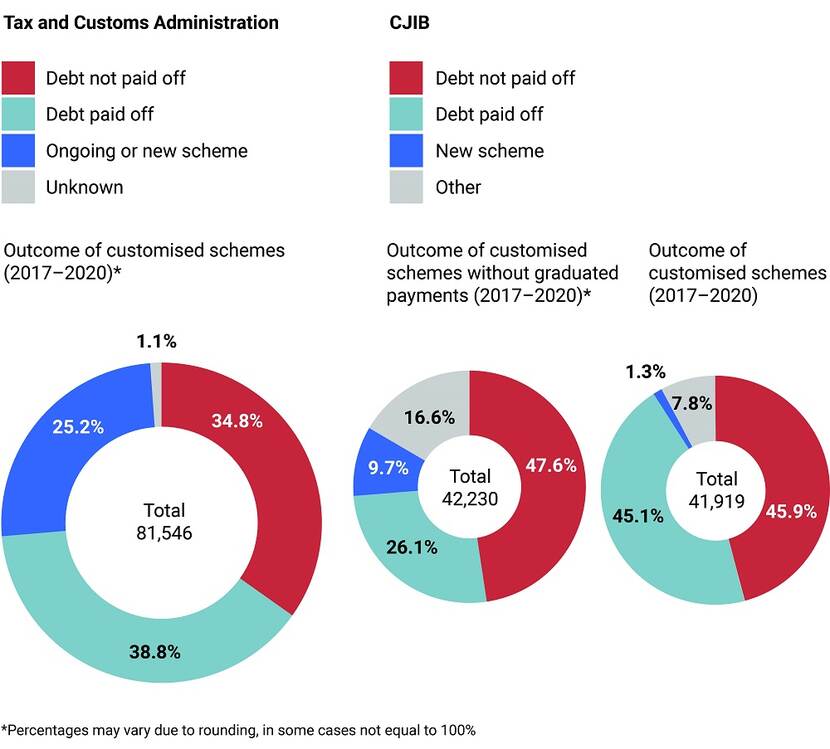Payment schemes and government debt collection
The 3 largest government debt collectors in the Netherlands give little thought to vulnerable citizens whose debt payments are so high they are not left with enough money to live on. The payment schemes offered to thousands of people with problematic debts are less than optimal, especially if the schemes are customised.
In an audit report published on 23 March 2023, the Court of Audit makes recommendations to improve the debt repayment schemes offered by the Tax and Customs Administration, the Central Judicial Collection Agency (CJIB) and the central office for the collection of exceptional medical insurance contributions (CAK).
Communication on standardised schemes clear and transparent
If a standardised payment scheme is agreed with a citizen, communication from the largest government debt collectors is clear and the scheme is accessible. This is important because many citizens are helped in this way. The Tax and Customs Administration alone agrees more than 165,000 standardised schemes a year and the CJIB, which collects traffic fines, etc., agrees more than 122,000. Transparency and clarity also increase the propensity to pay off debts. In the Court of Audit’s opinion, the standardised schemes offered by the Tax and Customs Administration and CJIB are effective. Then data provided by CAK, which collects chronic care and social support insurance contributions, however, was of such poor quality that the Court of Audit could not determine how many schemes CAK agreed each year or how much debt was paid off. CAK cannot say how often payment schemes are agreed or how much debt is repaid on time. At the Tax and Customs Administration and CJIB, 71% of debts are repaid on time. These standardised schemes prevent the debt from increasing further and ensure that repayments are actually made. The fact that standard schemes are usually all that are needed to reduce payment arrears is good for the public purse. In total, the schemes are agreed for many millions of euros every year.
Customised payment schemes fall short
Standardised schemes, however, are not always appropriate.
Less is paid in customised schemes than standardised schemes

The audit found that in 46-48% of the customised schemes agreed by the CJIB, payments were not made on time, if at all. At the Tax and Customs Administration, in more than a third of payments were not made on time, if at all. If someone does not have enough money to repay a debt to the government within the standard payment term or has a complex debt problem, the approach taken by the largest government debt collectors is inadequate. This is a cause of concern. On average, the Tax and Customs Administration and CJIB agree 20,000 customised schemes every year. The customised schemes offered by the Administration, CJIB and CAK are inadequately effective.
Information is not clear
Citizens are not informed in full, if at all, about customised payment schemes. Websites, documents and other forms of communication do not explain when agreements can be tailored to an individual’s circumstances. Even if tailoring is necessary, the Tax and Customs Administration, for example, does not explain that a scheme can last longer than 12 months, a missed opportunity according to the Court of Audit. More is possible only if a standardised scheme is refused and a citizen appeals against the offer. For many vulnerable citizens, however, initiating an appeal procedure is inconceivable on account of the stress and other deterrents.
Subsistence level not ensured
Under the government debt collection policy, the government must ensure that people have enough money to cover their living expenses. The audit found that neither the CJIB nor CAK had clear internal agreements to calculate and ensure a subsistence level of income. There were no indications in the files that citizens’ ability to make repayments was taken into account. People can be living below the statutory subsistence level if they are paying off more than one debt. The Tax and Customs Administration has priority over other organisations or businesses to collect tax debts but takes no account of debts to other organisations or institutions. Its payment schemes for people with large or problematic debts are not realistic and are feasible only on paper.
What data did we use in our audit?
We used a variety of audit methods. We analysed documents and held interviews at the Tax and Customs Authority, CAK, the CJIB and the Ministry of Social Affairs and Employment. We requested data files on payment schemes agreed in 2017-2020. The quality and utility of the data are considered in the appendix to the report. We wrote to citizens with experience with the debt collection organisations and invited them to contact us. We sent nearly 2,000 letters, which resulted in 46 interviews. We also analysed files.
Current status
The Minister for Poverty Policy, Participation and Pensions wrote in her response to the audit report that various government organisations would work together to improve debt collection and prevent or address problematic debts. However, she does not refer to the problem that the customised payment schemes offered by the 3 organisations can leave citizens with less than subsistence level income.
The report was submitted to parliament on 23 March 2023. The Minister for Poverty Policy’s response was published on www.rekenkamer.nl on the same date.
We held a briefing to inform the House of Representatives about the audit.
Do you have any feedback about this audit or investigation?
We welcome all feedback about our audits and investigations. What do you think about the report? Do you have any questions about our work or need further information? Mail us at feedback@Rekenkamer.nl. We take all emails into account and treat them in confidence.